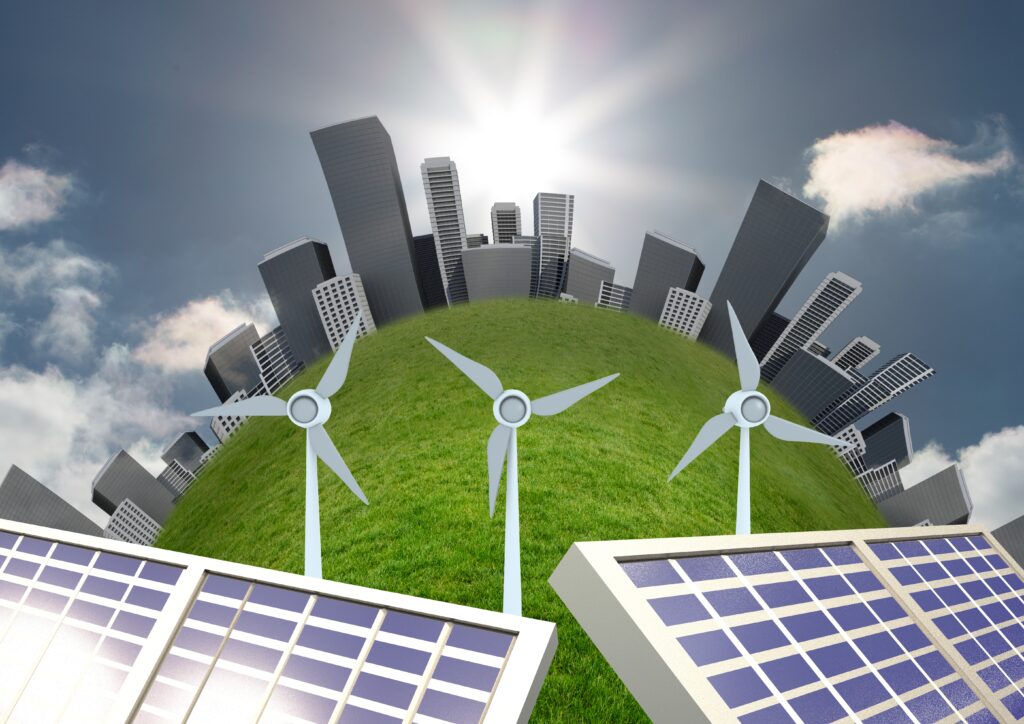Renewable Energy Technologies 2025 are reshaping the global energy landscape through innovation, efficiency, and sustainability. This year brings massive progress across solar power, hydrogen production, wind energy, and advanced storage systems. With rising investments, smart grid integration, and green hydrogen breakthroughs, these technologies are paving the way toward a low-carbon, resilient future. In this article, we explore the top innovations powering the clean energy revolution in 2025.
🌞1. Solar Power & New Variants
- Traditional PV panels continue to reign supreme: scalable from home rooftops to utility-scale solar farms.
- Perovskite solar cells have achieved efficiencies in excess of 25%, and tandem perovskite–silicon panels are cracking 30% efficiency—hinging on flexible, lightweight solar in various forms
- Bifacial panels can capture light on both sides, producing ~30% more in reflective conditions.
- Floating solar farms over bodies of water enhance efficiency (cooling effect) and save land; extensively implemented in Asia.
Efficiency & Innovation
- High-efficiency cells now exceed 25% efficiency, with tandem perovskite-silicon designs reaching 28.6%news.
- Flexible, lightweight perovskite films are being commercialized, such as Japan’s $1.5 billion initiative targeting solar on buildings and infrastructure.
Stability Breakthroughs
- Northwestern’s protective coatings tripled device lifespan under stress, maintaining ~26% efficiency.
- Pusan University used crown-ether passivation (B18C6) to enhance humidity resilience and efficiency (~21.7%)
- Innovative interface agents (e.g., gefitinib) recently improved open‑circuit voltage and stability, boosting efficiency from ~17% to ~19.6%
- Research on carbon nanotube electrodes and recyclable modules suggests enhanced durability and eco‑friendly end‑of‑life handling .
Flexible Tandem Tech
- New flexible perovskite/silicon tandem cells nearing 30% certified efficiency, maintaining performance under bending .
🌬️ 2. Wind Energy
- World installed capacity exceeded 800 GW in 2024, generating ~8.1% of electricity.
- In 2023, global wind energy capacity rose to 1,021 GW, adding a record 116.6 GW—up 50% from 2022—covering 100 GW onshore and nearly 11 GW offshore
- Onshore wind dominates (~93% of capacity), though offshore is growing fast and accounted for 9% of new capacity in 2023 .
- Total global wind power generation is projected to grow ninefold from 2,000 TWh in 2022 to 18,300 TWh by 2050 .
- Technologies include floating wind turbines and vertical-axis wind turbines, which facilitate the installation of deeper waters and city centers.

🌊 3.Hydropower & Marine Energy
- Conventional hydropower continues to be a central part, particularly for base-load and peaking power.
- World footprint: Exports approximately 15% of global electricity (~4,210 TWh in 2023).
- Reservoir vs run-of-river: Reservoir schemes provide flexibility to balance demand and flood management, while run-of-river has less environmental impact but is based on water flow.
- Modernization & integration: Digital upgrades in focus—predictive maintenance, AI control—and pumped storage power plants serving energy storage and hydrogen production.
- Tidal and wave power (such as Sweden’s Sotenäs wave power plant) are new, but still niche due to expensive development costs.
- Installed base: Around 513 MW of cumulative ocean power (tidal range + stream + wave) by the end of 2023; only 2 MW installed that year.
- Key technologies:Tidal range plants feature large plants such as Rance (240 MW, France) and Sihwa (254 MW, South Korea).
- Tidal stream farms: ~41 MW installed since 2010; projects such as MeyGen (6 MW in Scotland) are expanding.
- Wave machines: ~27 MW installed post-2010; technology in development with prototypes such as floating OE35 machines and EU-funded test schemes .
Strengths & challenges:
- Strengths: Reliable, 24/7 power with high energy density—synergizes with wind/solar.
- Weaknesses: High up-front cost, tough marine environment, complicated grid integration, and still-restricted commercial readiness.
🌋4. Geothermal Energy & Microreactors
- Enhanced Geothermal Systems (EGS) access heat in deep dry rock, promising enormous, stable baseload power.
- Strengths: Provides round-the-clock, low-carbon baseload power with high utilization rates (~75%) and strong grid support .
- Skilled shift: Leveraging oil-and-gas drilling techniques lowers costs and expands potential—could meet up to 15% of global electricity demand growth by 2050.
- Key hurdles: High upfront investment, long permitting timelines, site risk, and need for costly cost reductions before widespread deployment.
- Conventional geothermal power plants produce 10.7 GW world-wide with negligible emissions.
- Microreactors, a nuclear-adjacent technology, provide low-carbon, compact 20 MW units for remote or specialty power requirements.
Microreactors
- Definition: Small nuclear units (<20 MW), container-transportable, for remote locations, data centres, defense, and industrial sites .
- Strengths: Factory-assembled, low-carbon, run-for-years without refuelling, expandable, and safer (passive heat-pipe designs minimize accident risk).
- Current status: Industry worth ~$647 M in 2025, expected to grow ~19% per annum to $8.9 B by 2037 .
- Weaknesses: High initial costs, complicated licensing/regulations, and embryonic supply chains—albeit microreactors have attracted interest from energy companies and technology companies.
🔋5. Energy Storage Systems
- Grid-scale storage: BESS (battery energy storage systems), flow batteries, thermal systems such as molten salt, and sodium-ion alternatives.
- Fast market growth: storage installations almost doubled annually; worldwide BESS projections indicate CAGR ~27% through 2025.
- Battery Energy Storage Systems (BESS):
- Capacity increased globally from ~90 GWh in 2023 to 175 GWh in 2024, with China, the EU, and the U.S. accounting for 90% of the installations .
- Prices have decreased dramatically: utility-scale lithium-ion installations dipped below US $140/kWh in 2023 (down from ~$800 in 2010), with LFP chemistries becoming more prevalent .
- Long-Duration Energy Storage (LDES):
- Alternatives such as thermal or compressed-air systems are ~US $232–293/kWh—lower than lithium-ion when discharge is longer than 8 hours.
- Flow batteries (vanadium-redox) are scaling—China was the lead with 2.4 GWh capacity in 2023, although supply of vanadium is a bottleneck.
- Ultra-Long Duration Solutions:
- Iron-air technology (e.g., Form Energy) raised US $405 M towards 100-hour storage, with initial installations expected in 2025 .
- Pumped-hydro initiatives such as Australia’s Snowy 2.0 can store hundreds of GWh, effectively being giant “grid batteries”.

🧪6. Green Hydrogen & Fuel Cells
- Green hydrogen (renewable-based electrolysis) is growing rapidly—$75 billion invested, with India aiming for 5 M tonnes/year in 2030.
- Hydrogen-fueled fuel cells are being implemented in heavy-duty vehicles and stationary power generation.
- New production processes: electrolysis through urine/urea have been developed, maximizing cost and energy effectiveness.
Green Hydrogen
- Advantage: Manufactured through renewable-powered electrolysis, it has zero CO₂ emissions, stores huge energy weight-efficiently, and is able to decarbonise heavy industry, shipping, and seasonal energy storage.
- Challenge: Expensive at present—2–3 × the price of fossil hydrogen. Infrastructure (electrolysers, pipelines, storage) requires huge investment, and intermittent renewable supply impacts constant production
Fuel Cells
- Advantage: Turn hydrogen into electricity with 60 %+ efficiency, only producing water—perfect for backup power, remote systems, and vehicles.
- Challenge: Excessive costs (fuel and vehicles), scarce refueling infrastructure, and safety/storage concerns—fuel cell buses are ~2.5× more expensive per km than battery buses
🤝7. Smart Grids & Digital Integration
- AI-based grid management: Maximizes demand–supply matching, improves resilience, decreases outages and costs .
- Use AI & IoT for real-time monitoring, demand forecasting, and predictive maintenance, enhancing grid reliability and reducing energy waste.
- Enable two-way power flows from distributed sources (e.g., rooftop solar and home batteries), integrating them into Virtual Power Plants (VPPs).
- Smart grids + IoT: Real-time monitoring, virtual power plants (VPPs), and peer-to-peer energy trading over blockchain are making decentralized, efficient, secure energy systems possible .
- Blockchain Integration
- Supports secure, transparent peer-to-peer energy trading and certificate tracking via decentralized ledgers.
Benefits
- Better energy balance with renewables, grid resilience, optimized asset usage, and new consumer (prosumer) opportunities
Challenges & Risks
- Increased cyber vulnerabilities—smart meters, inverters, and IoT devices can be entry points for attacks
- Technical hurdles: interoperability, blockchain scalability/latency, data privacy, and high implementation costs
🔬8. Decarbonization & Supportive Tech
- Carbon capture & storage (CCS), including direct-air capture, getting established—130+ big plants worldwide .
- Rare-earth recycling enhances sustainability in turbine/panel supply chains.
- Biomass, biofuels, and biodegradable materials minimize waste and provide renewable feedstocks.
- Captures CO₂ from industrial sources or directly from the air, then injects it underground or repurposes it into fuels, materials, or concrete.
- Major projects like Norway’s Longship and the UK’s Acorn are operational, though high costs and infrastructure (pipelines, policy support) remain key challenges.
- Next-gen sorbents—like MOFs and advanced amines—are improving CO₂ capture efficiency and reducing energy use in the regeneration process.
- Thermal storage (e.g., molten salt) integrates with CCUS to stabilize energy loads and reduce emissions.
- Techniques like mineralization (e.g., injecting CO₂ into basalt rock) permanently lock away carbon.
- Recycling innovations target rare-earth elements and battery materials, supported by blockchain-traced supply chains.

🌍 Global Trends & Highlights
- Investment boom: A $1.6 trillion pipeline is flowing into clean tech, with India, Mexico, Brazil leading sunbelt country leadership.
- Big Tech: Google and Meta are heavily investing in data center geothermal, a sign of strategic green energy utilization..
🔋 Green Energy Tech: Theory in Brief
Perovskite & Bifacial Solar
- Strength: Lightweight and adjustable with high energy conversion efficiency.
- Weakness: Chemical and environmental instability—degradation due to water, heat, UV, and ion migration—continue to hamper long-term application
Floating Solar
- Strength: Effective land use and thermal cooling enhance efficiency.
- Weakness: Complicated installation and upkeep on water; environmental disturbance and electrical corrosion hazards.
Wind (Offshore & VAWT)
- Strength: Scalable green power, appropriate for windy or urban locations.
- Weakness: Variability of energy and environmental limitations such as seabed impact and wind-shadow effects.
Geothermal & Microreactors
- Strength: Offers reliable low-carbon base-load power.
- Weakness: Capital intensiveness and regulatory hurdles, particularly for deep drilling and nuclear-related ones.
Green Hydrogen & Fuel Cells
- Strength: Facilitates decarbonizing heavy industries & transport via clean hydrogen production.
- Weakness: Infrastructural availability shortage and high production costs (still 3× fossil-based hydrogen).
Energy Storage Systems (Batteries, Flow, Thermal)
- Strength: Enables round-the-clock renewable energy via load balancing.
- Weakness: High expense and dependence on rare materials such as lithium and vanadium.
Smart Grids & Blockchain
- Strength: Increase resilience, decentralization, and peer-to-peer energy trading.
- Weakness: Greater complexity of the network and cyber‑security threats necessitate strong protection .
Carbon Capture & Recycling Tech
- Strength: Reduce emissions and encourage circular supply chains (e.g., reuse of rare-earths).
- Weakness: High setup expenses and sluggish take-up in sectors.
✅ The Takeaway
Renewable energy in 2025 is a multi-pronged revolution—led by advancements in solar technology, storage, hydrogen, digital integration, and sustainable supply chains. Ongoing innovation, strategic investments, and policy support are vital to bring these at scale to global markets.



